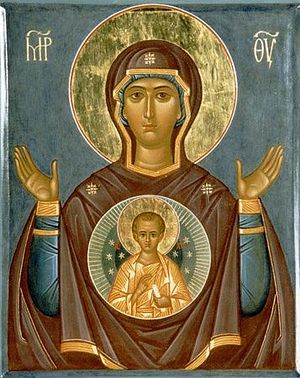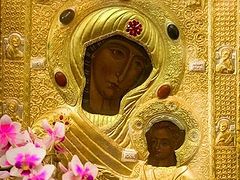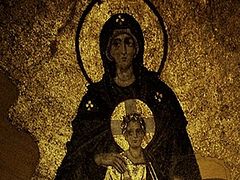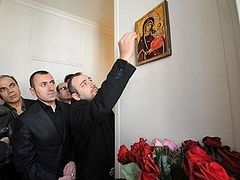The icon of the Mother of God which is known as the "Sign" depicts the Most Holy Theotokos seated, with her hands raised in prayer. Depicted upon a round shield or sphere, upon her breast, is the Divine Infant - the Saviour-Emmanuel - in an attitude of blessing. Such a representation is of a type manifested in the very earliest iconographic depictions of the Theotokos. In the tomb of Saint Agnia in Rome, the Theotokos is depicted with arms extended in prayer, and with the Infant seated on her knees.
This image dates to the fourth century. Moreover, there is a well known sixth century icon of the Theotokos, known as the "Nikopeia" icon, in which the Most Holy Theotokos is depicted, seated on a throne, and holding before her in both hands an oval shield bearing the image of the Saviour-Emmanuel. Icons of the Mother of God known by the name of the "Sign" appeared in Russia during the eleventh and twelfth centuries, and took on that name after the miraculous sign given by the Novgorod icon in the year 1170.
In that year, the combined forces of landed princes under the direction of the son of Andrei Bogoliubov, prince of Suzdal, approached the walls of Great Novgorod. The people of Novgorod were left nowhere to turn for help but to God. Day and night they prayed, asking the Lord not to abandon them. On the third night, Ilya [Elias], Archbishop of Novgorod, heard a lovely voice directing him to take from the Church of our Lord's Transfiguration, on Ilya Street, the image of the Most Holy Theotokos, and to carry it out to the city wall. As they were carrying the icon, the enemy loosed upon the procession a cloud of arrows, one of which struck the face of the Theotokos written upon the icon. From her eyes tears began to flow, and her icon turned to face the city. Immediately after the appearance of such a divine sign, the attackers were struck with an inexplicable terror, and began to strike down one another. The people of Novgorod, emboldened by God, fearlessly entered the fray, and were victorious.
In memory of the miraculous intercession of the Queen of Heaven, Archbishop Ilya immediately directed the establishing of a feast day in honor of the Sign of the Mother of God, a feast day which the entire Russian Church continues to annually celebrate to this day. The Athonite monk Pachomius Logothetos, who was present at the celebration of the icon in Russia, composed two canons for this feast. On some Novgorod icons are depicted, in addition to the Theotokos and the Pre-eternal Infant, the miraculous events of 1170. The miraculous icon remained for 186 years in the Church of our Lord's Transfiguration on Ilya Street. In the year 1356, a church in honor of the Sign of the Most Holy Theotokos was built for the icon in Novgorod, and became the Cathedral Church of the Monastery of the Sign.
Many copies of the "Sign" Icon are known throughout Russia. Many of them shone forth with miracles in their local churches and became known by the names of those places in which the miracles occurred. Among such copes are the Dionysius-Glushitsk, Abalatsk, Kursk, Seraphim-Ponetaevsk Icons and others Icons of the Sign.




